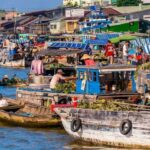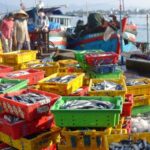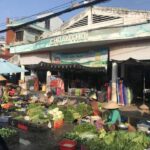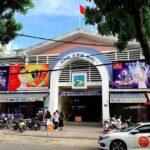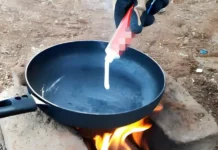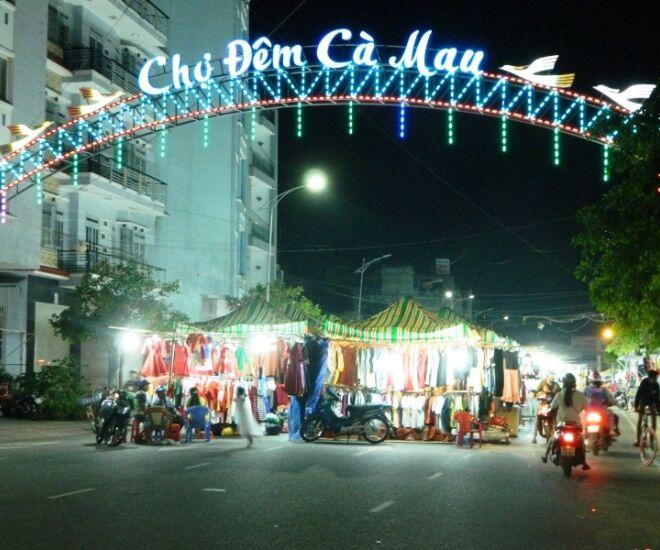
From Traditional Floating Markets to Modern Food Streets
According to “Gia Định Thành Thông Chí”, a historical record by Trịnh Hoài Đức, the precursor to Cà Mau night market was the floating markets on Tam Giang and Ông Đốc rivers dating back to the 18th century. At that time, trading activities mostly took place on boats and canoes due to the dominant riverine geography.
During the French colonial period, with the initiation of urban planning, these floating markets gradually moved onshore, forming the precursor of today’s bustling night markets: Phường 2 and Phường 4 markets.
A turning point came in 2010 when Cà Mau city was recognized as a type-II urban area. This led to numerous infrastructure development projects, which spurred the expansion and growth of the night market. In 2015, Phường 7 night market was upgraded to a seafood wholesale market, catering to the growing demands of locals and tourists.
Notably, 2022 marked a significant milestone with the inauguration of the Night Food Street, featuring 28 stalls adjacent to the Central Conference Square. This event showcased the province’s strategy to develop its night-time economy, aiming to become an appealing destination on the Mekong Delta tourism map.
A Diverse Array of Night Markets
Currently, Cà Mau’s night markets are mainly concentrated in the city center, each offering unique attractions:
Cà Mau City Night Food Street, located next to the Central Conference Square, boasts 28 stalls operating from 5 PM to midnight. It primarily serves fresh seafood in a spacious and modern setting.
Phường 7 Night Market, situated by the river, retains the characteristic “bến trên dưới thuyền” (wharf above, boats below) feature of the Mekong Delta. It is renowned for its diverse range of agricultural and aquatic products from both brackish and freshwater regions.
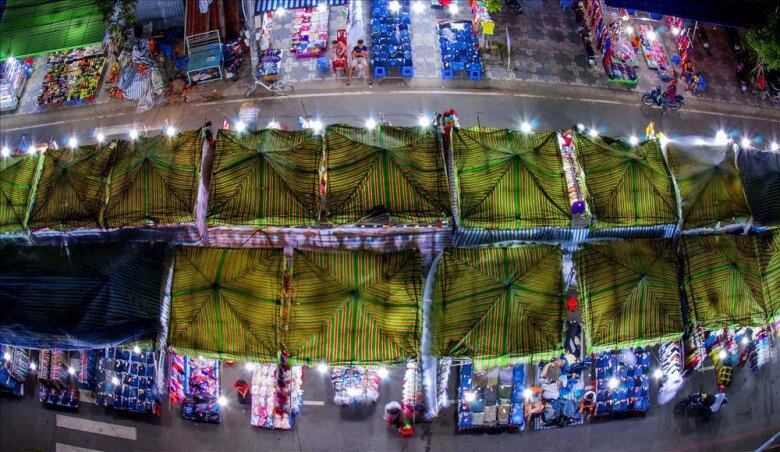
Phường 8 Night Market, located near the fishing port, focuses on the trade of seafood caught at night, providing fresh produce for locals and visitors.
Phường 9 Food Street, along Phan Ngọc Hiển Street, is lined with numerous grilled snakehead fish restaurants, attracting diners who crave this local delicacy.
Conveniently, these markets are all within a 3-5 km radius, forming a well-connected network for sightseeing, shopping, and culinary adventures.
Captivating Riverside Ambiance
Unlike the Gành Hào floating market, which operates mainly during the day, Cà Mau night market exudes an urban vibe while retaining the essence of the riverine region.
In terms of architecture, the stalls are well-designed, featuring roofs and modern lighting systems, especially at the food street next to the Central Conference Square. Getting around is also convenient, as visitors can easily reach the markets by motorbike or taxi since they are located within the city.
However, the Phường 7 market by the river maintains the quintessential “bến trên dưới thuyền” characteristic of the Western South region. Here, visitors can combine boat rides with shopping and dining experiences, creating unforgettable memories.
Seafood Paradise and Delights of the Mekong Delta
Geographically blessed with a coastline, Cà Mau night market is renowned for its fresh seafood and local specialties.
Cà Mau’s famous Năm Căn crab delights diners with its firm meat and golden roe, priced at 250,000–400,000 VND/kg depending on size. Ba Khía shrimp paste, a specialty of Rạch Gốc, is traditionally made and commonly paired with hot rice or wrapped in rice paper.
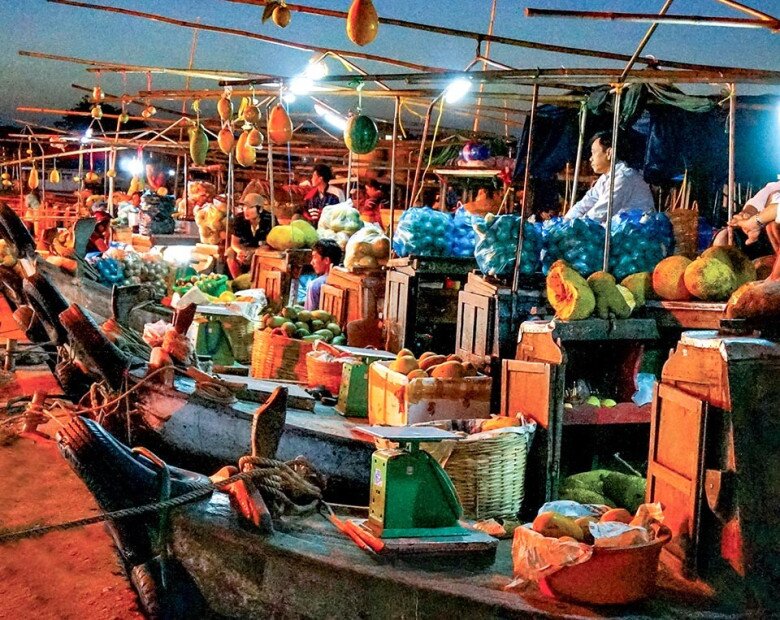
Naturally sun-dried shrimp, sold mainly at Phường 8 night market, range from 500,000–700,000 VND/kg. The mudskipper, caught in the mangrove forest, is often grilled or fried with salty spices.
In addition to seafood, the night market offers a variety of local agricultural products such as Lai Vung pink tangerines grown in Thới Bình district, priced at 20,000–30,000 VND/kg, and U Minh forest honey, sold in glass jars for approximately 150,000 VND/liter.
Handicrafts are also a must-buy at the Cà Mau night market, especially the locally woven lác mats adorned with unique patterns, priced at 200,000–300,000 VND each, and Đước wood carvings depicting birds and fish, reflecting the U Minh forest’s essence.
Vibrant Street Food Scene
The cool evening climate makes grilled dishes a popular choice at the Cà Mau night market.
Grilled snakehead fish marinated in lemongrass and chili, cooked over charcoal, and served with vermicelli and forest vegetables, costs only 50,000 VND per serving. Spicy grilled squid seasoned with satay costs 70,000 VND each. Grilled len snails with spring onions, a specialty at Ốc Bươu restaurant in the night food street, sells over 100 servings every night.
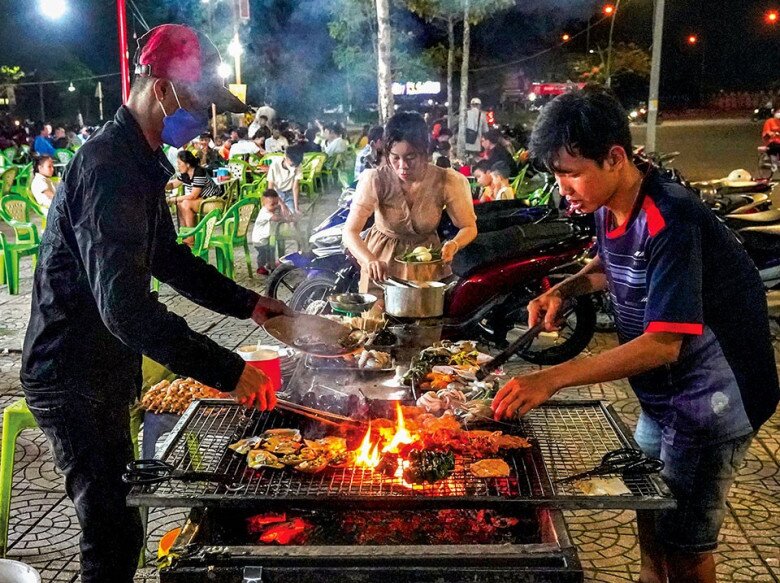
Signature dishes of the Mekong Delta, such as sour mefish hot pot with bitter vegetables, cost 150,000 VND for a small pot. Another delicacy is nghêu rice noodles, made from rice flour and served with sweet clam broth, for only 20,000 VND per bowl.
Unique drinks like rượu trái giác, a liquor made from forest jackfruit from the U Minh forest with a mild astringent taste, cost 50,000 VND per glass. Pineapple and ginseng drink, a refreshing blend of pineapple, ginseng, and honey, is also a specialty not to be missed, priced at 15,000 VND per glass.
Shopping Tips for Cà Mau Night Market
To fully enjoy the Cà Mau night market, visitors should keep in mind some tips for choosing quality products.
When buying live seafood, check for clear eyes, red gills, and firm flesh. Avoid buying stale fish from stalls near the roadside. When purchasing Ba Khía shrimp paste, opt for jars with clear brine and closely packed shrimp, with a standard price of 100,000–150,000 VND per kg.
Regarding bargaining and payment, visitors can haggle over prices for handicrafts and may get a 10–20% discount when buying in bulk. Approximately 60% of the stalls at the Cà Mau night market accept e-wallet payments, offering convenience to both domestic and international visitors.
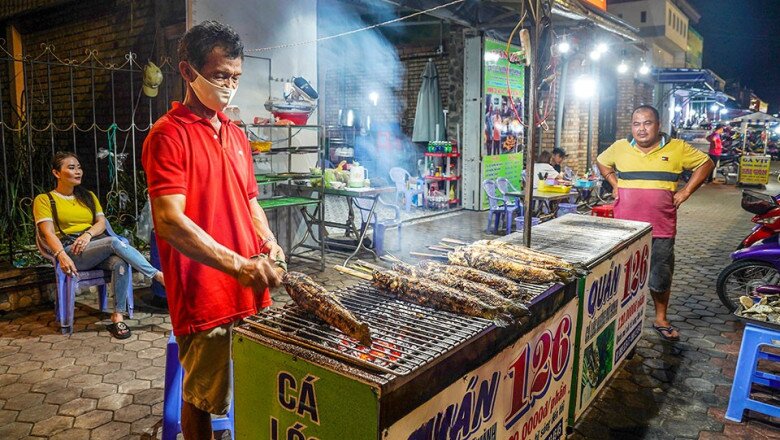
The Cà Mau night market is not only a repository of the riverine culture but also an emerging economic and tourism powerhouse. The fusion of tradition and modernity, the interplay between floating and onshore markets, gives the Cà Mau night market its unique character. Every corner of the market tells a story about the land and its people, from the flavorful dishes to the distinctive cultural ambiance, collectively painting a vibrant picture of the lifestyle, culture, and cuisine of this southernmost region of Vietnam.
If you ever find yourself in Cà Mau, don’t miss out on spending an evening exploring and immersing yourself in this extraordinary setting, where the nightlife is as vibrant as the daytime, and every street corner exudes the distinctive charm of this land of the southern tip.
The Market: A Ca Mau Pride, a Magnet for Foreigners Thanks to Its Unique Culture
The Nam Can Floating Market in Ca Mau is a captivating destination for those eager to explore the unique cultural charm of the Mekong Delta. This vibrant market offers a glimpse into the bustling life of the locals, with hundreds of boats laden with regional produce, delectable specialties, and a distinctive “floating market” trading experience. Immerse yourself in the lively atmosphere, indulge in the aromatic delights, and uncover the captivating traditions of this enchanting corner of Southern Vietnam.
The Ultimate Guide to Phu Quoc’s Best-Kept Secret: A Local’s Guide to the Island’s Cheapest Seafood Market
Nestled in the south of the pristine island of Phu Quoc, An Thoi Market is not just a shopping destination, but a treasure trove of cultural heritage unique to the coastal community. With its rich history and diverse offerings, the market has become a must-visit attraction for travelers seeking an authentic taste of Phu Quoc.


























